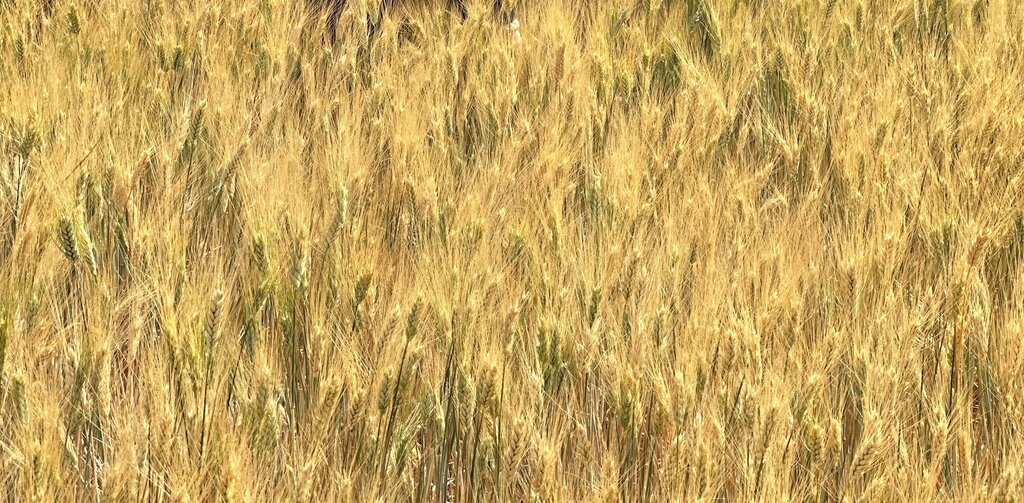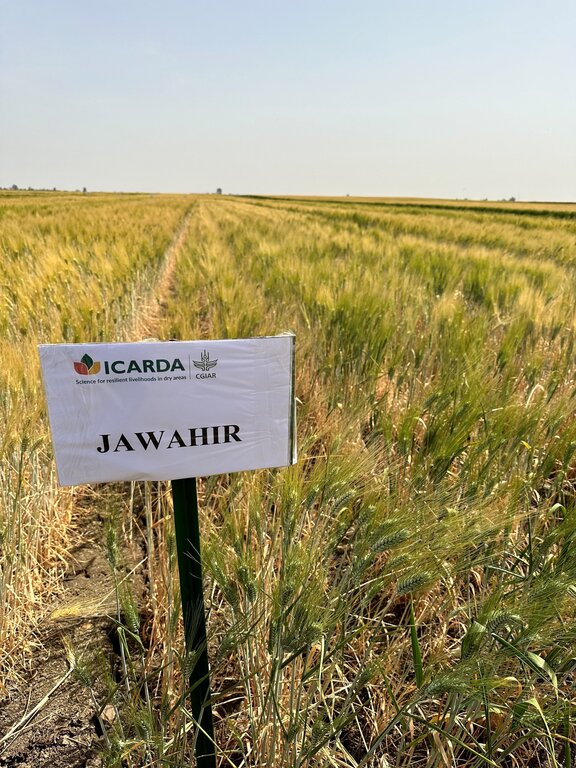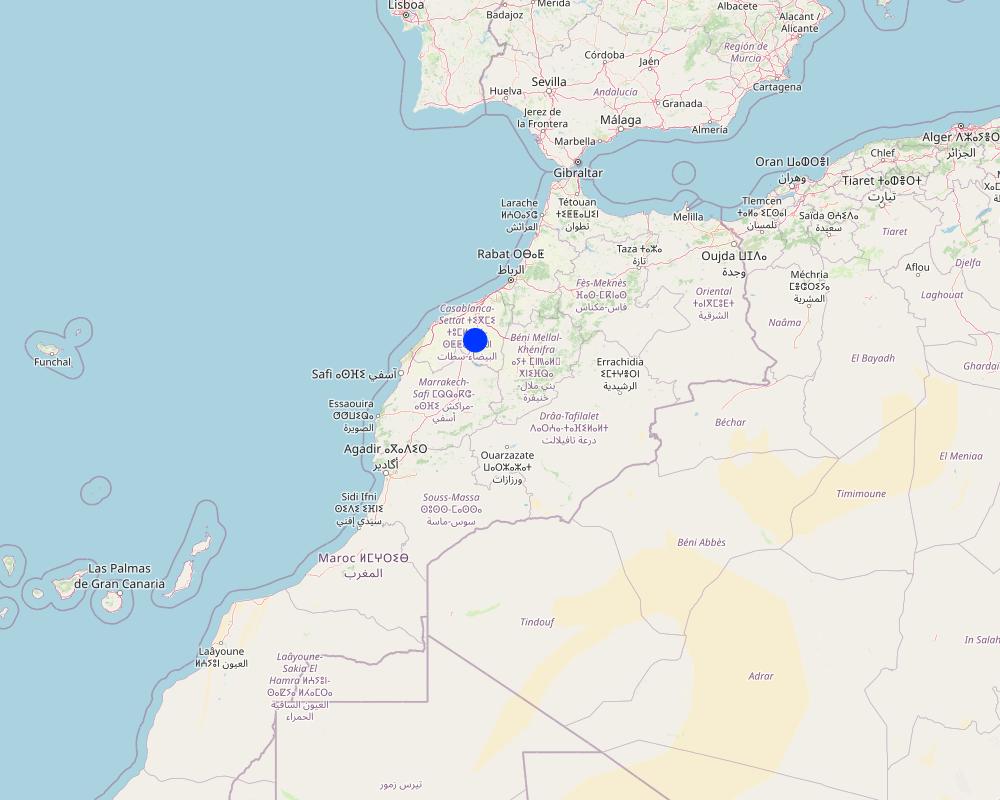Drought tolerant durum wheat variety: Jawahir [摩洛哥]
- 创建:
- 更新:
- 编制者: Joren Verbist
- 编辑者: –
- 审查者: William Critchley, Rima Mekdaschi Studer
technologies_6804 - 摩洛哥
查看章节
全部展开 全部收起1. 一般信息
1.2 参与该技术评估和文件编制的资源人员和机构的联系方式
关键资源人
Principal Investigator Genetic Innovation:
Bassi Filippo
International Center of Agriculture Research in the Dry Areas (ICARDA)
摩洛哥
Research Assistant, Entomology:
Boulamtat Rachid
International Center of Agriculture Research in the Dry Areas (ICARDA)
摩洛哥
Breeding Lead:
Ferrahi Moha
Institut National de la Recherche Agronomique (INRA)
摩洛哥
有助于对技术进行记录/评估的项目名称(如相关)
ICARDA Institutional Knowledge Management Initiative有助于对技术进行记录/评估的机构名称(如相关)
International Center for Agricultural Research in the Dry Areas (ICARDA) - 黎巴嫩1.3 关于使用通过WOCAT记录的数据的条件
编制者和关键资源人员接受有关使用通过WOCAT记录数据的条件。:
是
1.4 所述技术的可持续性声明
这里所描述的技术在土地退化方面是否存在问题,导致无法被认为是一种可持续的土地管理技术?:
否
2. SLM技术的说明
2.1 技术简介
技术定义:
Jawahir, an improved durum wheat variety, serves as a resilient solution to the challenges of climate change in dry areas by offering disease and pest resistance, drought tolerance, higher grain and straw yields, as well as cost savings, thereby enhancing farmers' income and sustainability.
2.2 技术的详细说明
说明:
Climate change exacerbates the difficulties faced by farmers in dry areas by amplifying drought conditions. Limited water availability and higher temperatures disrupt crop growth and heighten the vulnerability of plants to pests such as the Hessian fly (Mayetiola destructor). This leads to increased risks of crop damage, reduced yields, and economic losses in these regions.
Genetically improving crop varieties can help overcome these issues by making crops more resilient. An international collaboration led by the International Center of Agricultural Research in Dry Areas (ICARDA-Morocco) has delivered six ground-breaking new durum wheat and barley varieties tolerant to increasingly severe droughts ravaging the region. Improvement is performed through Molecular Breeding which consists of markers to select specific traits and conventional phenotypic.
This case study revolves around an improved durum wheat variety named Jawahir. The main advantages of this variety are:
•Cost savings: Jawahir's suitability for zero tillage helps to eliminate the need for ploughing, reducing the associated costs for farmers.
•Disease and pest resistance: Jawahir's resistance to diseases and pests, including the Hessian fly, minimizes the expenses related to fungicides and insecticides.
•Higher grain yield: Compared to competing varieties (like Karim and Kanakis), Jawahir can yield an additional 700 kilograms per hectare under dry conditions, increasing farmers' productivity and potential income.
•Enhanced straw yield: Jawahir also produces an additional 500 kilograms of straw compared to competing varieties during drought, providing additional feed for fodder and for mulching under conservation agriculture systems.
Jawahir was introduced in the Settat-Safi region (Morocco) where annual precipitation is between 300 and 400 mm. While cultivation practices may vary, it is recommended to include Jawahir in a conservation agriculture (zero/ minimum till) system. Crop management includes machine seeding in November at a rate of 200 kg per hectare corresponding to approximately 300 plants per square meter. Fertilizer application consists of manually applying 200 kg of NPK (15:20:15) in November and 100 kg of urea in February. Herbicide application of 1 litre is suggested in February. Harvesting takes place in June using a combine harvester, and during July and August, the stubble is left for grazing. Following this crop management system, the costs per hectare are estimated to be around 2610 Moroccan Dirham (about 261 USD) per hectare.
The direct gross income from Jawahir, based on grain yield, is approximately 1,120 USD per hectare, based on a yield of 3,200 kilograms and a selling price of 35 USD per 100 kilograms. The additional gross income from straw yield is around 1,100 USD per hectare, assuming a yield of 5,500 kilograms and a price of 20 USD per 100 kilograms. This results in a total direct gross income of 2,220 USD per hectare.
However, if processed into couscous for human consumption, Jawahir's higher semolina yield (i.e. more kilograms of semolina per kilogram of grain milled) and better semolina color means an extra gross income of 4,560 USD per hectare. Additionally, when the straw is used for animal fattening, the extra output per hectare is around 900 kilograms of lamb meat (based on a conversion rate of 6 kilograms of feed to 1 kilogram of meat). Then the total extra gross income from production of meat is 5,500 USD per hectare.
Including both direct and indirect income, Jawahir provides a total gross income of approximately 12,280 USD per hectare from grain, straw, couscous, and animal fattening.
In conclusion, enhanced crop varieties like Jawahir offer increased resilience to the challenges posed by climate change in dry areas. These varieties provide benefits such as cost savings, disease and pest resistance, and improved yields. By adopting these varieties, farmers can enhance their agricultural productivity and mitigate the impacts of climate change on their livelihoods.
Acknowledgement: ICARDA’s work on breeding is supported by the Accelerated Breeding Initiative of the CGIAR and The Crop Trust. The variety release was through INRA Morocco.
2.3 技术照片
2.5 已应用该技术的、本评估所涵盖的国家/地区/地点
国家:
摩洛哥
区域/州/省:
Settat-Safi
具体说明该技术的分布:
- 均匀地分布在一个区域
如果不知道精确的区域,请注明大致覆盖的区域:
- 0.1-1 平方千米
技术现场是否位于永久保护区?:
否
Map
×2.6 实施日期
注明实施年份:
2022
2.7 技术介绍
详细说明该技术是如何引入的:
- 在实验/研究期间
- 通过项目/外部干预
3. SLM技术的分类
3.1 该技术的主要目的
- 改良生产
- 降低灾害风险
- 适应气候变化/极端天气及其影响
- 创造有益的经济影响
- 创造有益的社会影响
3.2 应用该技术的当前土地利用类型
同一土地单元内混合使用的土地::
否

农田
- 一年一作
- Durum what: Jawahir
每年的生长季节数:
- 2
采用间作制度了吗?:
否
采用轮作制度了吗?:
是
如果是,请具体说明:
Jawahir can be included in crop rotations, especially well fitted with Conservation Agriculture. This could include legumes (e.g., vetch or faba bean) as well.
3.3 由于技术的实施,土地使用是否发生了变化?
由于技术的实施,土地使用是否发生了变化?:
- 否(继续问题3.4)
3.4 供水
该技术所应用土地的供水:
- 雨养
3.5 该技术所属的SLM组
- 改良植物品种/动物品种
3.6 包含该技术的可持续土地管理措施

农艺措施
- A5:种子管理,改良品种
3.7 该技术强调的主要土地退化类型

化学性土壤退化
- Cn:肥力下降和有机质含量下降(非侵蚀所致)

生物性退化
- Bp:害虫/疾病增加,捕食者减少
3.8 防止、减少或恢复土地退化
具体数量名该技术与土地退化有关的目标:
- 减少土地退化
- 适应土地退化
4. 技术规范、实施活动、投入和成本
4.1 该技术的技术图纸
技术规范(与技术图纸相关):
The recommended plant density is around 300 plants per square meter.
4.2 有关投入和成本计算的一般信息
具体说明成本和投入是如何计算的:
- 每个技术区域
注明尺寸和面积单位:
1 Hectare
其它/国家货币(具体说明):
Morrocan Dirham
如相关,注明美元与当地货币的汇率(例如1美元=79.9巴西雷亚尔):1美元=:
10.0
注明雇用劳工的每日平均工资成本:
80
4.5 维护/经常性活动
| 活动 | 时间/频率 | |
|---|---|---|
| 1. | Seeding | November |
| 2. | First fertilizer application (NPK) | November |
| 3. | Second fertilizer application (Urea) | Ferbruary |
| 4. | Herbicide application | February |
| 5. | Harvesting | June |
| 6. | Stubble left for grazing | June - August |
4.6 维护/经常性活动所需要的费用和投入(每年)
| 对投入进行具体说明 | 单位 | 数量 | 单位成本 | 每项投入的总成本 | 土地使用者承担的成本% | |
|---|---|---|---|---|---|---|
| 劳动力 | Seeding | Person-day | 2.0 | 80.0 | 160.0 | |
| 劳动力 | Fertilizer application | Person-day | 4.0 | 80.0 | 320.0 | |
| 劳动力 | Herbicide application | Person-day | 2.0 | 80.0 | 160.0 | |
| 劳动力 | Harvesting | Person-day | 2.0 | 80.0 | 160.0 | |
| 设备 | Seeder | Machine-hour | 2.0 | 100.0 | 200.0 | |
| 设备 | Combine | Machine-hour | 2.0 | 200.0 | 400.0 | |
| 植物材料 | Jawahir seed | 100 Kilogram | 2.0 | 130.0 | 260.0 | |
| 肥料和杀菌剂 | First fertilizer: NPK (15:20:15) | 100 Kilogram | 2.0 | 250.0 | 500.0 | |
| 肥料和杀菌剂 | Second fertilizer: Urea | 100 Kilogram | 1.0 | 200.0 | 200.0 | |
| 肥料和杀菌剂 | Herbicide | Liter | 1.0 | 250.0 | 250.0 | |
| 技术维护所需总成本 | 2610.0 | |||||
| 技术维护总成本,美元 | 261.0 | |||||
5. 自然和人文环境
5.1 气候
年降雨量
- < 250毫米
- 251-500毫米
- 501-750毫米
- 751-1,000毫米
- 1,001-1,500毫米
- 1,501-2,000毫米
- 2,001-3,000毫米
- 3,001-4,000毫米
- > 4,000毫米
农业气候带
- 半干旱
- 干旱
5.2 地形
平均坡度:
- 水平(0-2%)
- 缓降(3-5%)
- 平缓(6-10%)
- 滚坡(11-15%)
- 崎岖(16-30%)
- 陡峭(31-60%)
- 非常陡峭(>60%)
地形:
- 高原/平原
- 山脊
- 山坡
- 山地斜坡
- 麓坡
- 谷底
垂直分布带:
- 0-100 m a.s.l.
- 101-500 m a.s.l.
- 501-1,000 m a.s.l.
- 1,001-1,500 m a.s.l.
- 1,501-2,000 m a.s.l.
- 2,001-2,500 m a.s.l.
- 2,501-3,000 m a.s.l.
- 3,001-4,000 m a.s.l.
- > 4,000 m a.s.l.
说明该技术是否专门应用于:
- 不相关
5.3 土壤
平均土层深度:
- 非常浅(0-20厘米)
- 浅(21-50厘米)
- 中等深度(51-80厘米)
- 深(81-120厘米)
- 非常深(> 120厘米)
土壤质地(表土):
- 中粒(壤土、粉土)
土壤质地(地表以下> 20厘米):
- 中粒(壤土、粉土)
表土有机质:
- 低(<1%)
5.4 水资源可用性和质量
地下水位表:
5-50米
地表水的可用性:
匮乏/没有
水质(未处理):
不良饮用水(需要处理)
水质请参考::
地下水
水的盐度有问题吗?:
是
该区域正在发生洪水吗?:
否
5.5 生物多样性
物种多样性:
- 低
栖息地多样性:
- 低
5.6 应用该技术的土地使用者的特征
定栖或游牧:
- 定栖的
生产系统的市场定位:
- 混合(生计/商业)
非农收入:
- 低于全部收入的10%
相对财富水平:
- 贫瘠
个人或集体:
- 个人/家庭
机械化水平:
- 机械化/电动
性别:
- 女人
- 男人
土地使用者的年龄:
- 中年人
5.7 应用该技术的土地使用者使用的平均土地面积
- < 0.5 公顷
- 0.5-1 公顷
- 1-2 公顷
- 2-5公顷
- 5-15公顷
- 15-50公顷
- 50-100公顷
- 100-500公顷
- 500-1,000公顷
- 1,000-10,000公顷
- > 10,000公顷
这被认为是小规模、中规模还是大规模的(参照当地实际情况)?:
- 小规模的
- 中等规模的
5.8 土地所有权、土地使用权和水使用权
土地所有权:
- 个人,未命名
- 个人,有命名
土地使用权:
- 个人
用水权:
- 个人
土地使用权是否基于传统的法律制度?:
是
5.9 进入服务和基础设施的通道
健康:
- 贫瘠
- 适度的
- 好
教育:
- 贫瘠
- 适度的
- 好
技术援助:
- 贫瘠
- 适度的
- 好
就业(例如非农):
- 贫瘠
- 适度的
- 好
市场:
- 贫瘠
- 适度的
- 好
能源:
- 贫瘠
- 适度的
- 好
道路和交通:
- 贫瘠
- 适度的
- 好
饮用水和卫生设施:
- 贫瘠
- 适度的
- 好
金融服务:
- 贫瘠
- 适度的
- 好
6. 影响和结论性说明
6.1 该技术的现场影响
社会经济效应
生产
作物生产
饲料生产
生产故障风险
收入和成本
农业投入费用
注释/具体说明:
When used in Conservation Agriculture
农业收入
工作量
注释/具体说明:
When used in Conservation Agriculture
社会文化影响
食品安全/自给自足
生态影响
减少气候和灾害风险
干旱影响
对现场影响的评估(测量)进行具体说明:
Data was retrieved from field trials and expert (also farmer) estimation.
6.2 该技术的场外影响已经显现
对场外影响(测量)的评估进行具体说明:
Not applicable/relevant
6.3 技术对渐变气候以及与气候相关的极端情况/灾害的暴露和敏感性(土地使用者认为的极端情况/灾害)
渐变气候
渐变气候
| 季节 | 增加或减少 | 该技术是如何应对的? | |
|---|---|---|---|
| 年温度 | 增加 | 非常好 |
气候有关的极端情况(灾害)
气候灾害
| 该技术是如何应对的? | |
|---|---|
| 热浪 | 好 |
| 干旱 | 好 |
生物灾害
| 该技术是如何应对的? | |
|---|---|
| 昆虫/蠕虫侵扰 | 好 |
注释:
Very well again Hesian fly
6.4 成本效益分析
技术收益与技术建立成本相比如何(从土地使用者的角度看)?
短期回报:
非常积极
长期回报:
非常积极
技术收益与技术维护成本/经常性成本相比如何(从土地使用者的角度看)?
短期回报:
非常积极
长期回报:
非常积极
6.5 技术采用
- 1-10%
如若可行,进行量化(住户数量和/或覆盖面积):
4 farms have adopted for seed production
在所有采用这项技术的人当中,有多少人是自发的,即未获得任何物质奖励/付款?:
- 0-10%
注释:
Four farms do not receive subsidies, but do receive technical support.
6.6 适应
最近是否对该技术进行了修改以适应不断变化的条件?:
否
6.7 该技术的优点/长处/机会
| 土地使用者眼中的长处/优势/机会 |
|---|
| Drought tolerant |
| Resistant to pests and diseases |
| Higher yield than other varieties |
| 编制者或其他关键资源人员认为的长处/优势/机会 |
|---|
| Although it is recommended to cultivate within Conservation Agriculture, it can be easily incorporated in conventional systems |
6.8 技术的弱点/缺点/风险及其克服方法
| 土地使用者认为的弱点/缺点/风险 | 如何克服它们? |
|---|---|
| Primary risk is the potential failure of seed production in the early stages. | To support the production process to the fullest extent possible. |
| 编制者或其他关键资源人员认为的弱点/缺点/风险 | 如何克服它们? |
|---|---|
| Primary risk is the potential failure of seed production in the early stages, which could prevent Jawahir from reaching its full market potential. | To support the production process to the fullest extent possible. |
7. 参考和链接
7.1 信息的方法/来源
- 实地考察、实地调查
- 与SLM专业人员/专家的访谈
- 根据报告和其他现有文档进行编译
(现场)数据是什么时候汇编的?:
2022
7.3 链接到网络上的相关信息
标题/说明:
Filippo Bassi, Hajar Brahmi, Abdelhadi Sabraoui, Ahmed Amri, Nasserlehaq Nsarellah, Nachit Miloudi, Ayed Al-Abdallat, Ming-Shun Chen, Abderrahim Lazraq, Mustapha El Bouhssini. (8/2/2019). Genetic identification of loci for Hessian fly resistance in durum wheat. Molecular Breeding, 39 (2).
URL:
https://hdl.handle.net/20.500.11766/10902
标题/说明:
Noureddine El Haddad, Miguel Sanchez-Garcia, Andrea Visioni, Jilal Abderrazek, Rola El Amil, Amadou T. Sall, Wasihun Lagesse, Shiv Kumar Agrawal, Filippo Bassi. (11/11/2021). Crop Wild Relatives Crosses: Multi-Location Assessment in Durum Wheat, Barley, and Lentil. Agronomy, 11 (11).
URL:
https://hdl.handle.net/20.500.11766/66379
标题/说明:
Noureddine El Haddad, Hafssa Kabbaj, Meryem Zaim, Khaoula El Hassouni, Amadou T. Sall, Mounira Azouz, Rodomiro Ortiz, Michael Baum, Ahmed Amri, Fernanda M. Gamba, Filippo Bassi. (1/2/2021). Crop wild relatives use in durum wheat breeding: drift or thrift. Crop Science, 61 (1), pp. 37-54.
URL:
https://hdl.handle.net/20.500.11766/11254
链接和模块
全部展开 全部收起链接
无链接
模块
无模块






